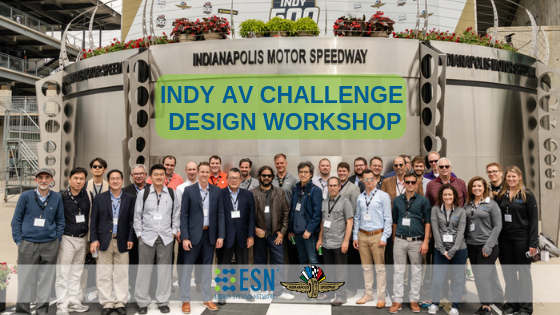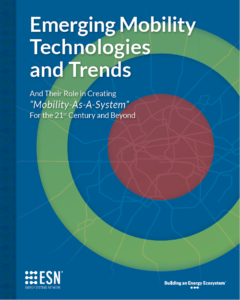NEWS RELEASE
IMS, Energy Systems Network Host Workshop To Develop High-Speed Competition
INDIANAPOLIS (May 23, 2019) The Indianapolis Motor Speedway and Energy Systems Network (ESN), the advanced energy technology initiative of the Central Indiana Corporate Partnership (CICP), are hosting some of the world’s leading autonomous vehicle technology researchers at the Racing Capital of the World on Thursday, May 23 to explore the potential for a global autonomous vehicle competition to be hosted in Indianapolis.
Nearly 15 years ago, the DARPA Grand Challenge gave birth to the modern-day autonomous vehicle (AV) industry by awarding a $1 million prize to the team that could first complete a 132-mile course in the southwestern U.S. desert. Today, a group of more than 20 researchers from industry and academia is gathered to develop what may become the successor to DARPA, spurring a new wave of innovation and AV commercialization. The goal of the workshop is to develop potential objectives and rules for such a competition, and to discuss prospective timelines, vehicles and other core elements.
“The Indianapolis Motor Speedway was conceived and built more than 100 years ago as a proving ground for automotive innovation and discovery,” IMS President J. Douglas Boles said.
“This gathering at the Racing Capital of the World provides an opportunity to embrace our heritage and again serve as a catalyst for the next generation of vehicle technologies in both motorsports competition and wider consumer platforms.” – Doug Boles, IMS President
“ESN is thrilled to be working with IMS to look for ways to bring technological innovations to the world’s greatest racing venue, and beyond,” said Paul Mitchell, president and CEO of Energy Systems Network.
The first phase of this exploration started in the fall of 2018 in Mountain View, California, with a gathering hosted by Sebastian Thrun, whose Stanford University team won the DARPA Grand Challenge in 2005. Thrun, the CEO of KittyHawk and co-founder of Udacity, is among a group of stakeholders advising the development of this potential new competition.
Reilly Brennan, a lecturer at Stanford’s Center for Automotive Research, partner at Trucks Venture Capital and another competition advisor, said: “Competitions that demand the highest performance thresholds have shown the ability to reveal new thinking, new collaborations and new talent. Over a decade ago, the DARPA Grand Challenge kick-started an important wave of innovation in automated vehicles that spilled over into the private sector and reinvigorated the research community. I believe a new competition focused on high-speed automated vehicles has the potential to do the same.”
The Indianapolis Motor Speedway has been an incubator and proving ground for automotive innovation since it opened in 1909. The facility originally was designed as a test track for the burgeoning automotive industry in Indianapolis at the turn of the century, and innovation began with the inaugural Indianapolis 500 in 1911, when winner Ray Harroun equipped and used what is believed to be the first rear-view mirror in automotive history on his Marmon “Wasp” race car.
Since then, countless automotive and motorsports breakthroughs have been fostered at IMS, including the first use of a Pace Car (1911), what is believed to be the first mass rolling start of a race (1911), the first use of four-wheel hydraulic brakes (1921), the first installation of color warning lights (1935), the first mandatory use of helmets (1935) and the first use of crash-data recorders (1993). As the 21st century dawned on the Speedway, arguably the greatest invention to protect drivers in a high-speed crash, the SAFER (Steel and Foam Energy Reduction) Barrier, was applied to the track’s four turns, in May 2002.
ESN, which is managing the project, has focused on innovations in transportation (including electrification, Mobility-as-a-Service, and autonomous first/last mile solutions) since its founding in 2009, and recently released a report titled Emerging Mobility Technologies and Trends that delves into the rapid transformation of this industry. ESN sees the opportunity to advance the commercialization of connected and automated vehicle (CAV) technologies through the development of this competition. Strategy Analytics – a consulting, advisory, and strategic market research services company – expects this industry to be worth $800 billion by 2035 and $7 trillion by 2050.
“While self-driving technologies and performance have advanced radically in recent years, solving for so-called ‘edge cases’ – those extreme and potentially dangerous roadway conditions – has in many cases remained elusive,” said Matt Peak, director of mobility at Energy Systems Network.
“A competition that challenges the stability and control of autonomous vehicles at ultra-high speeds and in close proximity to each other would have real-world applicability in highway scenarios, and aid in the deployment of technologies that help vehicles avoid accidents and make our roadways safer.” – Matt Peak, ESN
The participants of the workshop are experts and researchers from:
- Ariel University
- Clemson University – International Center for Automotive Research (CU-ICAR)
- Dallara Automobili
- Elevate Ventures
- Georgia Institute of Technology
- Indiana University–Purdue University Indianapolis (IUPUI)
- Kennesaw State University
- Kettering University
- Korea Advanced Institute of Science & Technology (KAIST)
- LHP Engineering Solutions
- Michigan State University – Autonomous and Connected Vehicle (CANVAS) Research Center
- Ohio State University – Center for Automotive Research (CAR)
- Purdue University
- Rose-Hulman Institute of Technology
- Texas A&M Transportation Institute (TTI)
- Toyota Mobility Foundation
- University of Alabama
- University of Florida Transportation Institute
- University of Virginia
- University of Waterloo
- Virginia Tech Transportation Institute (VTTI) – Center for Advanced Automotive Research
IMS and ESN envision using the input gathered from the workshop to further refine the concept, examine a potential competition framework, and work to engage additional stakeholders to support its possible implementation. For updated information as it becomes available, subscribe for email updates at www.indyavchallenge.com.
Contacts:
Alex Damron, Sr. Director of Communications, Indianapolis Motor Speedway
Phone: 317-492-6734 Email: [email protected]
Melissa Roberts, Chief of Staff, Energy Systems NetworkSpeedway
Phone: 317-501-4136 Email: [email protected]



